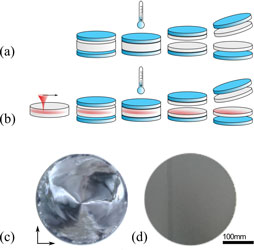Crossref Citations
This article has been cited by the following publications. This list is generated based on data provided by
Crossref.
Coll, Pablo Guimera
Meier, Rico
and
Bertoni, Mariana
2018.
Dynamics of Crack Propagation during Silicon Spalling.
p.
2537.
Swoboda, Marko
Rieske, Ralf
Beyer, Christian
Ullrich, Albrecht
Gesell, Gino
and
Richter, Jan
2019.
Cold Split Kerf-Free Wafering Results for Doped 4H-SiC Boules.
Materials Science Forum,
Vol. 963,
Issue. ,
p.
10.
Sivaramakrishnan Radhakrishnan, Hariharsudan
Cho, Jinyoun
Bearda, Twan
Röth, Julius
Depauw, Valérie
Van Nieuwenhuysen, Kris
Gordon, Ivan
Szlufcik, Jozef
and
Poortmans, Jef
2019.
Freestanding and supported processing of sub-70 μm kerfless epitaxial Si and thinned Cz/FZ Si foils into solar cells: An overview of recent progress and challenges.
Solar Energy Materials and Solar Cells,
Vol. 203,
Issue. ,
p.
110108.
Chen, Jie
and
Packard, Corinne E.
2021.
Controlled spalling-based mechanical substrate exfoliation for III-V solar cells: A review.
Solar Energy Materials and Solar Cells,
Vol. 225,
Issue. ,
p.
111018.
Raj, Vidur
Haggren, Tuomas
Wong, Wei Wen
Tan, Hark Hoe
and
Jagadish, Chennupati
2022.
Topical review: pathways toward cost-effective single-junction III–V solar cells.
Journal of Physics D: Applied Physics,
Vol. 55,
Issue. 14,
p.
143002.
An, Junyang
Shen, Ya
Roca i Cabarrocas, Pere
and
Chen, Wanghua
2022.
Fabrication of Crystalline Si Thin Films for Photovoltaics.
physica status solidi (RRL) – Rapid Research Letters,
Vol. 16,
Issue. 12,
Boyer, Jacob T.
Braun, Anna K.
Schulte, Kevin L.
Simon, John
Johnston, Steven W.
Guthrey, Harvey L.
Steiner, Myles A.
Packard, Corinne E.
and
Ptak, Aaron J.
2023.
Analysis of Crystalline Defects Caused by Growth on Partially Planarized Spalled (100) GaAs Substrates.
Crystals,
Vol. 13,
Issue. 4,
p.
681.
Jiang, Lu
Zhao, Shusen
Han, Shifei
Liang, Han
Du, Jiabao
Yu, Haijuan
and
Lin, Xuechun
2024.
CW laser-assisted splitting of SiC wafer based on modified layer by picosecond laser.
Optics & Laser Technology,
Vol. 174,
Issue. ,
p.
110700.
Zhao Shusen, 赵树森
He Hongzhi, 何宏智
Han Shifei, 韩世飞
Jiang Lu, 姜璐
Du Jiabao, 杜家宝
Yu Haijuan, 于海娟
Lin Xuechun, 林学春
and
Zhang Guling, 张谷令
2024.
透明硬脆材料激光剥离关键问题研究(特邀).
Infrared and Laser Engineering,
Vol. 53,
Issue. 1,
p.
20230487.
Xiangfu, Liu
and
Minghui, Hong
2024.
Micro-cracks generation and growth manipulation by all-laser processing for low kerf-loss and high surface quality SiC slicing.
Optics Express,
Vol. 32,
Issue. 22,
p.
38758.
Li, Yuhang
Zhang, Zhe
Song, Qi
Shi, Haiyan
Hou, Yu
Yue, Song
Wang, Ran
Cai, Shunshuo
and
Zhang, Zichen
2024.
Surface micromorphology and nanostructures evolution in hybrid laser processes of slicing and polishing single crystal 4H-SiC.
Journal of Materials Science & Technology,
Vol. 184,
Issue. ,
p.
235.
Wang, Lifeng
Liu, Lili
Wang, Yinan
Li, Xun
Li, Chenchen
and
Li, Ming
2024.
Slicing of large-size single crystals by ultrafast laser with external stress assistance.
Chinese Optics Letters,
Vol. 22,
Issue. 8,
p.
081601.
Lv, Boyang
Ye, Linzheng
Zhu, Xijing
Liu, Yao
Chuai, Shida
and
Wang, Zexiao
2024.
Ultrasonic-assisted stripping of single-crystal SiC after laser modification.
Ceramics International,
Vol. 50,
Issue. 22,
p.
48517.
Yao, Yongping
Chen, Qiu
Li, Bixue
Zhang, Jianfei
Wang, Rongkun
Bai, Meng
Liang, Runze
Ma, Longnan
Ma, Tiejun
Zhang, Jiayu
Xia, Jinbao
Nie, Hongkun
and
Zhang, Baitao
2025.
Influence of crystal orientation and incident plane on n-type 4H-SiC wafer slicing by using picosecond laser.
Optics & Laser Technology,
Vol. 182,
Issue. ,
p.
112174.
Al Balushi, Zakaria Y.
and
Kuech, Thomas F.
2025.
Comprehensive Semiconductor Science and Technology.
p.
304.
